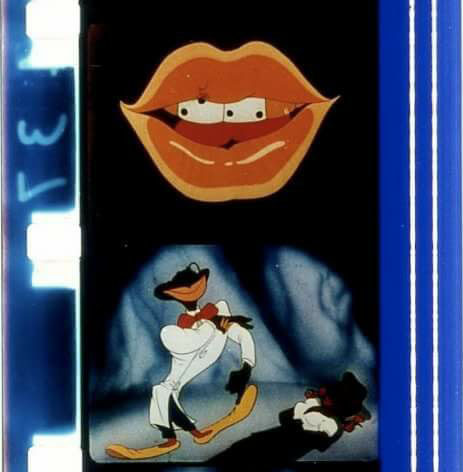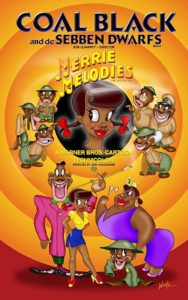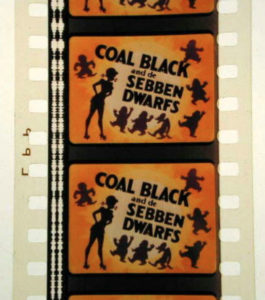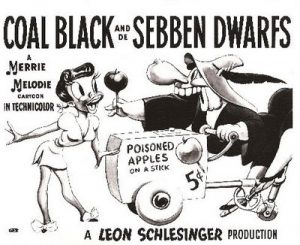
Very few books on the history of American animation leave out the film Coal Black an de Sebben Dwarfs. This 1942 “Merrie Melodies” cartoon from Warner Brothers is a one-film time capsule of the peak of American cartooning. The film displays energetic, elastic animation of its characters. It engages in a mixture of verbal and visual humor.
 The jazzy score and the vocal performances provide a perfect aural complement to the graphics, and the sounds gave the film an urban feel that was on a par with new star Bugs Bunny’s New York-ish speech. In addition, the studio’s parody of Walt Disney’s recent movie Snow White brings to the forefront the competition that animators at non-Disney studios felt against the cartoon giant.Coal Black was by no means going to displace Snow White’s popularity, but it announced to audiences that there was more than one way to tell a fairy tale.
The jazzy score and the vocal performances provide a perfect aural complement to the graphics, and the sounds gave the film an urban feel that was on a par with new star Bugs Bunny’s New York-ish speech. In addition, the studio’s parody of Walt Disney’s recent movie Snow White brings to the forefront the competition that animators at non-Disney studios felt against the cartoon giant.Coal Black was by no means going to displace Snow White’s popularity, but it announced to audiences that there was more than one way to tell a fairy tale.
Coal Black’s setting is modernized, in contrast to the “timeless” approach by Disney’s Snow White. Produced by Leon Schlesinger in 1942, Coal Black is set in World War II, and the dwarfs are small American soldiers on the homefront. The prince drives around in a limousine, and the heroine is a laundress who cooks for the seven soldiers. Although she is resurrected by a kiss, it is from one of the dwarfs instead of the prince. Also, there is no reference to her having a father.
And there’s one other thing–the entire cast is African American caricatures. Director Robert Clampett sought African Americans to voice the characters and perform the film’s music. Several books and articles have noted Clampett’s fondness for African American jazz and his insistence on the entertainers he hired for the film. As a result, the cartoon sounds unique among all the cartoons produced by Warner Brothers before or since Coal Black, with the possible exception of Clampett’s Tin Pan Alley Cats.
 The African American characters are part of the cartoon’s ultimate downfall, however. Coal Black was the first cartoon that the National Association for the Advancement of Colored People condemned. When issuing its statement of opposition in 1943, the organization claimed that the film hurt the Allied war effort by depicting US soldiers as dwarfs. The caricatures gave the enemy some useful propaganda to undermine the Allied cause, according to the NAACP. My book The Colored Cartoon discusses this controversy in greater detail. Regardless, the NAACP’s call for the cartoon’s removal from theaters fell on deaf ears, and the film received rave reviews. However, Coal Black did not ever have a “Blue Ribbon” reissue before becoming part of the television syndication package in 1956.
The African American characters are part of the cartoon’s ultimate downfall, however. Coal Black was the first cartoon that the National Association for the Advancement of Colored People condemned. When issuing its statement of opposition in 1943, the organization claimed that the film hurt the Allied war effort by depicting US soldiers as dwarfs. The caricatures gave the enemy some useful propaganda to undermine the Allied cause, according to the NAACP. My book The Colored Cartoon discusses this controversy in greater detail. Regardless, the NAACP’s call for the cartoon’s removal from theaters fell on deaf ears, and the film received rave reviews. However, Coal Black did not ever have a “Blue Ribbon” reissue before becoming part of the television syndication package in 1956.
Twelve years later Coal Black landed in the Censored Eleven, and there are several possible reasons why. All of the characters have the standard ethnic caricature of big lips, and the prince has dice for teeth–an homage to the hoary gambling stereotype attached to African Americans. Dialect abounds, right down to the prince’s full name “Prince Chawmin” and the full title of the cartoon itself. The songs also have the dialect, as when the heroine So White sings, “I washes all day.” Among the African American dwarfs is a Stepin Fetchit caricature, and the Wicked Queen is a bandanna and slippers away from a mammy caricature. In addition, any film that aroused the NAACP’s ire in 1943 was a shoo-in for inclusion in the Eleven in 1968.
 Also, the film’s depictions of African Americans reflected some realities of African American life in 1942, and these images may also have been part of the film’s undoing in 1968. The dwarfs are an all-African American military unit, and this grouping acknowledged that the United States did have at that time a segregated army. So White’s job as a laundress was one of the most common occupations for African American women at the time, especially in the Jim Crow South. Thankfully, the Armed Forces were integrated by 1968, and the Civil Rights Movement opened more vocational opportunities for African Americans. However, the airing of Coal Black on television reminded African American viewers of this recent past. Also, in 1968, the involvement of the US Armed Forces in the Vietnam War was at peak troop levels. At a time when Martin Luther King, Jr. was reminding people that integrated units could die together in Vietnam but not live together in Chicago, Coal Black brought to mind that the units weren’t always integrated, either. In other words, Coal Black was still not helpful to African American troop morale in 1968.
Also, the film’s depictions of African Americans reflected some realities of African American life in 1942, and these images may also have been part of the film’s undoing in 1968. The dwarfs are an all-African American military unit, and this grouping acknowledged that the United States did have at that time a segregated army. So White’s job as a laundress was one of the most common occupations for African American women at the time, especially in the Jim Crow South. Thankfully, the Armed Forces were integrated by 1968, and the Civil Rights Movement opened more vocational opportunities for African Americans. However, the airing of Coal Black on television reminded African American viewers of this recent past. Also, in 1968, the involvement of the US Armed Forces in the Vietnam War was at peak troop levels. At a time when Martin Luther King, Jr. was reminding people that integrated units could die together in Vietnam but not live together in Chicago, Coal Black brought to mind that the units weren’t always integrated, either. In other words, Coal Black was still not helpful to African American troop morale in 1968.
Essentially, Warner Brothers used African American cultural expression as an anti-Disney approach to animation, and in this regard Coal Black is not original. Max Fleischer had used African Americans as a collective creative muse in the 1930s, and Walter Lantz’s “Swing Symphonies” also did so during the war. However, the non-Disney studios were just searching for ways to compete with Disney without imitating him, and when they found their grooves, they discarded African American performance. Thus, no matter what free rein Clampett and other animators may have given to the African American performers to “do their thing,” the studios were always in control of the content. They did the production, the direction, the animation, and the dialect-filled writing–just like with the other ten films in the Censored Eleven.
You can see this film on Vimeo, CLICK HERE.
Additional info on this film was posted by Jim Korkis last year in this post.


 Christopher P. Lehman is a professor of ethnic studies at St. Cloud State University in St. Cloud, Minnesota. His books include American Animated Cartoons of the Vietnam Era and The Colored Cartoon, and he has been a visiting fellow at Harvard University.
Christopher P. Lehman is a professor of ethnic studies at St. Cloud State University in St. Cloud, Minnesota. His books include American Animated Cartoons of the Vietnam Era and The Colored Cartoon, and he has been a visiting fellow at Harvard University.



























Along with Tin Pan Alley Cats (among several other Black-oriented cartoons at the time), this cartoon was part of a trend that didn’t really last past1943: Black Hollywood musicals.
Well… it is easier to defend than D.W. Griffith’s THE BIRTH OF A NATION. They did include black performers in addition to Mel Blanc, right? That was very thoughtful of Mister Clampett.
At this point, we just have to throw in the towel and declare that anything that is at least a decade old is questionable. Too much as changed, especially now that we are in the midst of a Culture War and a #MeToo movement. For example, so much 1980s-90s TV entertainment now is embarrassingly dated. Popular shows like SEINFELD and FRIENDS make many modern viewers squirm with their blatantly homophobic humor, although the writers back then thought they were harmless in their “it is only a joke” mentality. Actually the earlier GOLDEN GIRLS has aged much more gracefully than these later shows, probably because their writers felt they HAD to be more socially progressive during that Dark Age: as Blanche tells Rose in one episode: “AIDS is not a bad person’s disease, Rose. It is not God punishing people for their sins.” Strong words for that time period.
There are some old films that are both disturbing and surprisingly hopeful. While Stepin Fetchit is brought to court for stealing chickens in JUDGE PRIEST (1934), Will Rogers starts talking about fishing with him and… lo and behold… the two walk to the creek like Humphrey Bogart and Claude Rains at the end of CASABLANCA. The “beginning of a beautiful friendship”? Should we attack that film for its stereotypes or praise it for its solidarity?
Back to COAL BLACK. I must admit that it doesn’t seem quite as “great” as I once viewed it to be in the past, probably after reading so much praise in books that tried to defend it on artistic grounds. I will try to excuse the joke about “Japs” getting “rubbed out” for free since they were The Enemy back then. It still bothers me, however, that a whole culture and race was viewed that way, while only specific Nazi figures were singled out for roasting. I am also mighty curious whose idea it was to introduce So White by her throbbing up and down… back-end!! Nothing wrong with that fetish, I guess. Come to think of it, comparing this cartoon to Tex Avery’s RED HOT RIDING HOOD is like comparing DEEP THROAT to THE IMMORAL MR. TEAS. Clampett just has to go to the extreme with too many “stiffening up” jokes to count. Also the obsession with huge lips that even “dwarf” So White’s lipstick kiss-marks. Even the bacon and eggs get all “minstrel”.
Omg!! Excellent Post. TY!!!
Thank you so much. I’m glad you liked it.
Outstanding review of this infamous hot-button cartoon, Christopher. You’ve nailed everything that it is.
Strictly for my own part, CB&TSD is always a contender in a Warners Top Ten list. I wouldn’t care to share it with children, but it always has a place in my collection. I’d kill for a restored C11 collection, but I’m not holding my breath. I presume these kind of films will be quietly shelved and forgotten over time, and maybe it’s just as well. There are bigger fish to fry going forward.
Thanks for a great series.
Thank you, GDX. I enjoyed writing the series.
Do my eyes deceive me? The annual Cartoon Research article about “Coal Black and De Sebben Dwarfs” and it ISN’T praising it as the greatest cartoon ever made? It ISN’T wailing and moaning about how unfair it is that the atrocious cartoon hasn’t seen the light of day in an official release? I’m stunned!
Bravo to author Christopher P. Lehman for FINALLY bringing a different perspective to these embarrassing cartoons featuring people of color. And kudos to Cartoon Research for finally growing up enough to feature regular columns by this excellent historian.
Thank you, John. I appreciate the compliments, and credit is certainly due to Jerry Beck for suggesting I do this series.
Racial stereotypes aside, that was some world-class cartooning there. You can tell Clampett and his staff really put extra effort on the animation, with every action synched to the beat and a lot of lush detail. Quite possibly one of the best cartoons the studio ever made.
I love her coat of arms!
First time seeing COAL BLACK, though I’ve heard a lot about it. I have to say, the cartoon might have its strong points, but I’m having a lot of trouble getting past being really embarrassed over the racial content.
@JLEWIS
I think you nailed the (misguided) current PC trend…
On the (many) staged “reality’ house-hunter shows, hubby is shown the living room & den, while wifey goes nuts over the bathroom and kitchen. It is 2018, yes? 😉
If it helps, I LOVE Flip The Frog! 🙂
.
It’s kinda sad it can only be shown in a high pitched/sped up (PAL?) version rather than the correct NTSC pitch
The NTSC pitch is not “correct”, either. This is a film made for theaters, intended to be projected at 24 frames per second. NTSC video runs slightly slower than that – its 29.97 frames per second equals 23.976 fps in progressive frames.
Time compressing for the sake of time-compressing helps nobody I find (unless a limitation of the video standard used).
Wow, who peed in your Cheerios this morning?
No, that is not true. Film transferred for NTSC or normal broadcast HD for North America is done at 23.976fps. The .1% difference between 24fps and 23.976 is not audible. It IS sped up 4% for PAL 25fps and overseas 25fps HD, and that’s very noticeable.
No doubt it deserves it’s place among the Censored 11, but man…that was one well made cartoon with a dynamite ending.
You called it, Jeff!
Toons like this, TAKEN IN CONTEXT, should be enjoyed for their artistry, without the baggage of past times.
There is a lot to enjoy in this short. I’ve always detected that Clampett was sincere in at least getting the culture depicted on screen and he did succeed in getting the spirit of it. Although he didn’t go about doing it in the best ways. The big lips, the dice, switchblades, dialect, and Eli Whitneys “Cotton Gin” references make the portrayals very disrespectful. At least Clampett has several other masterpieces to his credit that are without controversy.
Mr. Lehman, following your earlier comment on Chuck Jones’ ANGEL PUSS and his views on African American stereotypes of the era, what are your thoughts on what Clampett’s intentions were for his censored eleven films? Do you think he was sincere in wanting to portray the culture as he claimed in later years?
I think Clampett liked the sound of African American performance and wanted to use it in animation. But so did Max Fleischer, and both filmmakers used African American soundtracks for their versions of SNOW WHITE. The difference is that Fleischer did not have to use tasteless ethnic jokes like the dice-for-teeth and “cotton gin” scenes in order to make his film.
Max Fleischer had black performers in his cartoons but without big-lipped caricatures, whereas Bob Clampett, not just in this short but others, caricatured blacks in ways controversial even for his time. Actually Bob Clampett made fun of everyone in ways questionable even for his time. While Clampett was a big self-promotor who said shorts like this weren’t racist, I do think that for the most part he was just trying to be funny and would go to the extent that could be considered questionable, whether it was using red paint gags to make it look like a character’s bleeding or, in this case, racial stereotypes. Considering the time when this was made it’s actually likely there was an extent of biogotry on Clampett’s part but it’s not the worst his time had to offer and we’ll never know the extent of the bigotry as he’s gone.
As Jlewis has pointed out even stuff from the 90s is embarrassingly dated. An example of this in animation would be Tiny Toons Adventures. I haven’t seen much of it but I have heard that characters dressing up as the opposite gender was a gag in the show.
It has been a privilege to read this series over the past year. Now that the Infamous 11 have all been discussed, is it possible for this series to continue by looking at other shorts (maybe even those not made by Warners) with similar motifs that weren’t outright banned but were either edited into incoherence to get rid of the offending imagery or slowly dropped from circulation?
As uncomfortable as these shorts are to watch today, I still think they should be restored with the rest of the Warners animation catalog, to include the extra effort it would take to restore the title sequences to those that were reissued. Obviously they shouldn’t be put on Cartoon Network or the Boomerang app, but trying to bury them only makes them more likely to be exposed at the least opportune moment. Besides, thanks to the internet anyone can dial up these shorts any time they like with a minimum of effort, but without the benefit of the historical information provided in forums such as this.
Therefore, the distribution of such restorations would have be very carefully considered. Perhaps a limited edition set with historians and animators such as Mr. Lehman there to guide viewers?
Has anyone ever heard a reason for the disparity in the title character name, i.e., Coal Black in the title, and So White in the cartoon? I would have loved hearing the conversation surrounding this. I can’t even imagine if it was a contentious discussion or not, as it’s just such a weird thing!
This comes under the heading of No Good Deed Goes Unpunished. It’s my understanding that Clampett went to a performance of Duke Ellington’s JUMP FOR JOY, and was so knocked out by it that he went backstage afterwards to meet the musicians. He quickly learned that they couldn’t get studio work because you-know-why, so he insisted on hiring them for two cartoons, this and TIN PAN, and they got “white man’s pay” for a couple of days. But his “good deed” eventually got tarred as racism. Poor Bob.
Dan: I believe the cartoon was supposed to be titled “So White and the…” but Disney threatened to sue because it was so close to the original title, so the change–irrelevant as it is–was made.
Absolutely stunning cartoon. It is an artifact of its day, and oh my what an artifact in so many ways. It cannot be judged by today’s societal rules and taboos, nor by any “standards” that will inevitably arise. What we consider vices and virtues are not fixed–they change over time. What remains constant is the brilliance of every aspect of this animated short film, one of Clampett’s true gems. Could be his best cartoon, but I’ll leave that up to you.
I see.the same thing in videos today with black women, wtf? A stereotype on steroids!